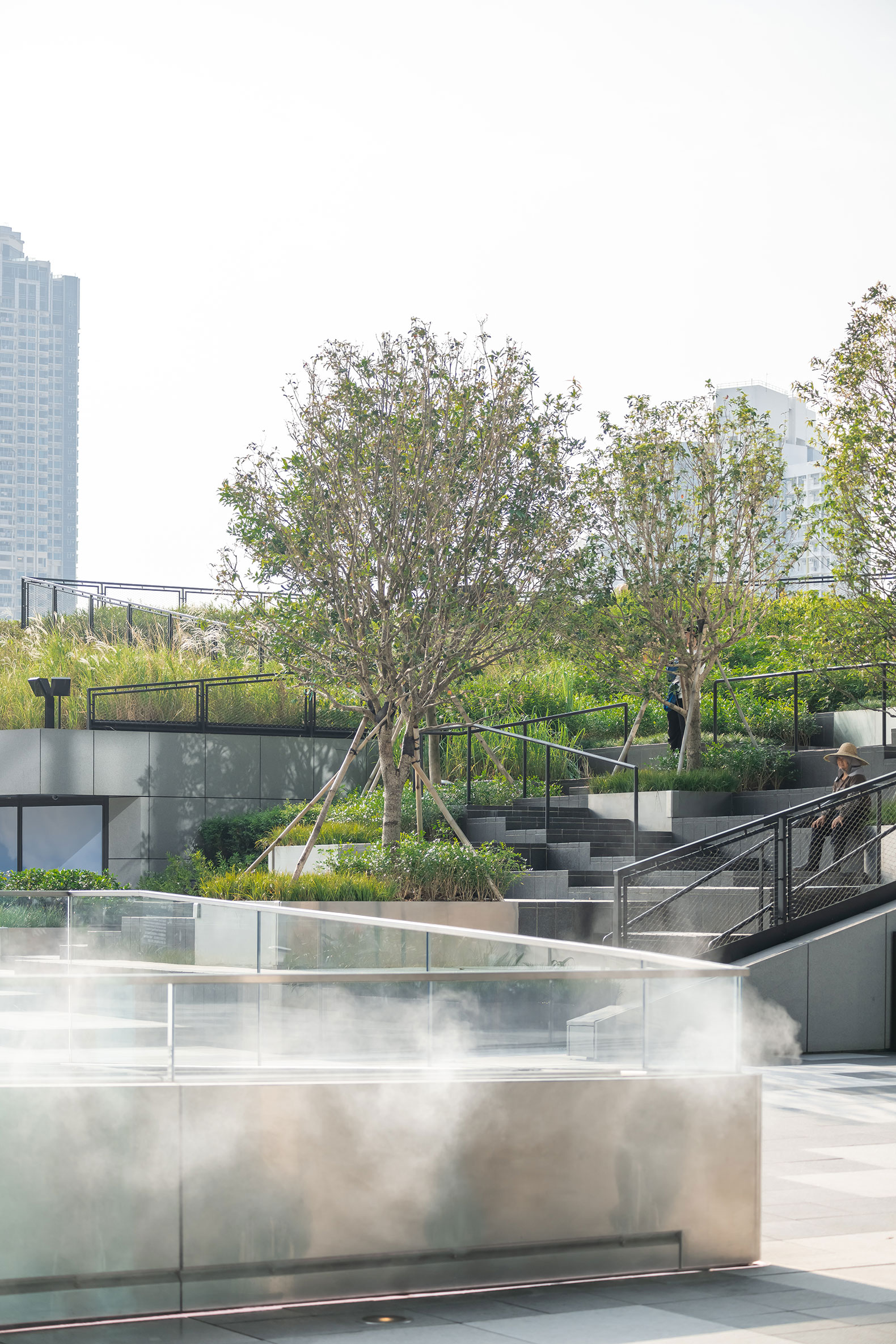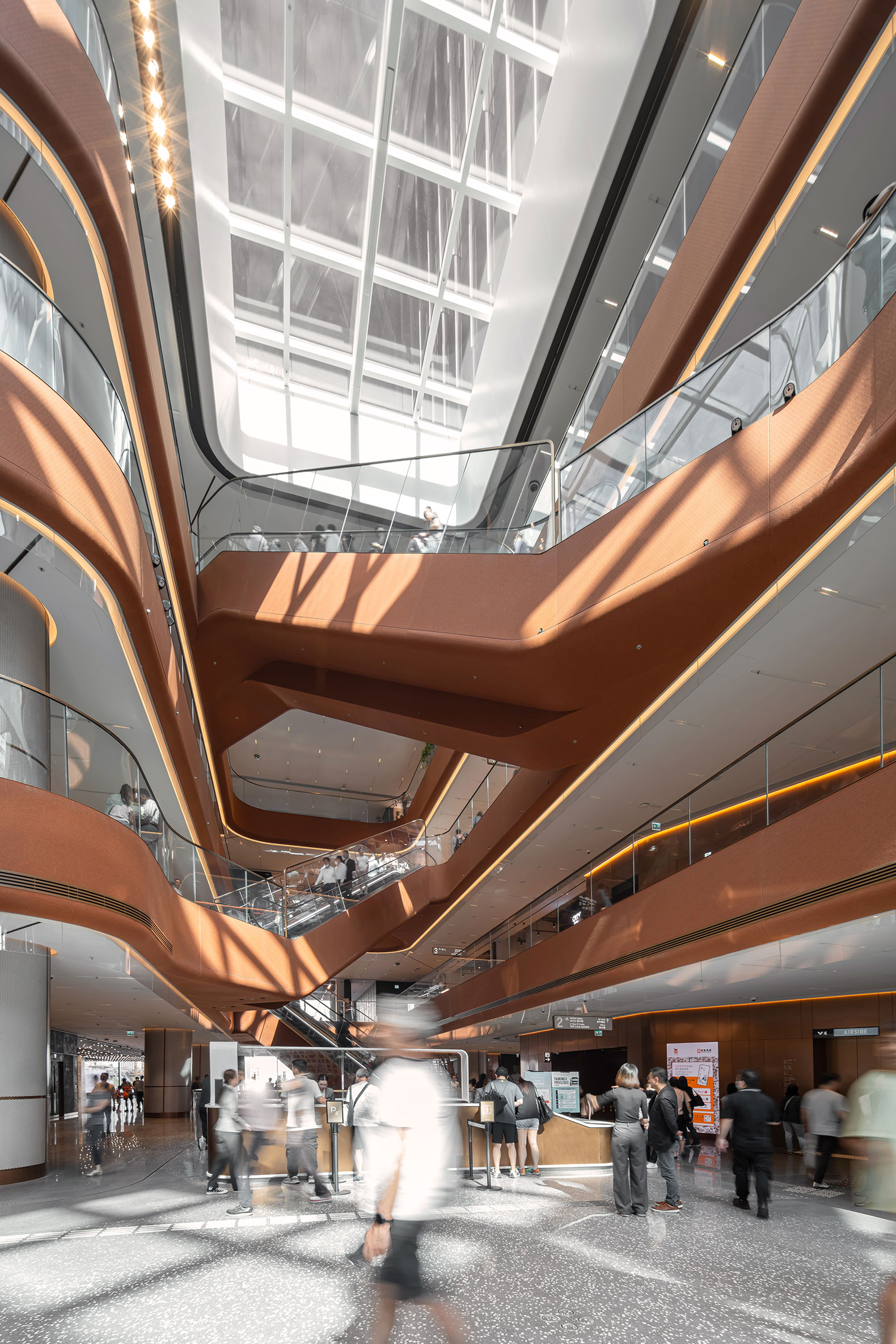The project was built to pay homage to the legacy of the textile industry, making legible the transformation of both the developer, Nan Fung Group, and Hong Kong itself, from its focus on textile manufacturing to real estate development, finance and technology. Therefore, the entire project, from the landscape to the façade, the mass and even the interiors, evoke aspects of textiles.
The building on the roof and podium levels houses more than 1,350 square meters of photovoltaic parks with walkable photovoltaic panels, it is the first commercial development to be connected to the Kai Tak district cooling system, using seawater. Thanks to these systems that include water sources, it is possible to counteract the urban heat island effect.

AIRSIDE by Snøhetta. Photograph by Kevin Mak.
Project description by Snøhetta
On the 25th closing anniversary of the famed Kai Tak airport in Hong Kong comes Snøhetta Asia’s latest project in the city – AIRSIDE, a LEED Platinum-certified mixed-use landmark that will be a gateway for a bustling redeveloped business district. The design weaves generous public spaces and gardens through a series of exterior plazas and rooftop landscapes suited for urban farming, restaurants, events, and recreation. The development incorporates a number of unprecedented sustainability practices, making it the first in Hong Kong to receive five of the highest green building certifications.
With views over Victoria Harbour and the Kai Tak River, the 177,670-square-metre project merges a 213-metre-tall tower with a second tower and its base in a continuous form. Set atop the Kai Tak MTR station, the design extends the urban landscape into the architecture itself, creating direct access between pedestrian transit areas, retail spaces at the tower’s base, and elevated garden landscapes.

AIRSIDE by Snøhetta. Photograph by Kevin Mak.
Creating a vibrant public realm and neighbourhood anchor
The building mass comprises five interconnected volumes that gradually step up from the Kai Tak River, lending the 213-metre tall tower an inviting presence at ground level. The building’s sculpted forms shape a series of human-scale urban spaces at ground level, and rooftop gardens with commanding views of Victoria Harbour and Kai Tak. Landscaped plazas ring the architecture, further integrating it into the surroundings and creating an engaging pedestrian realm. Both the tower and the base gently step down towards the southernmost corner, revealing the rooftops to the surrounding plaza and riverside promenade to create a sense of interconnection between them.
A generous elevated garden tops the podium containing the building’s central atrium, creating a signature public space that overlooks the surroundings with ample seating, water features, and planted areas. Below it, at the heart of the building, is a 60,000 square-metre multi-story retail atrium filled with natural light, creating a spacious community gathering and social space. Rising above the elevated garden is a tower containing 110,000 square metres of grade A office space. Together with nearby cultural and leisure facilities that are currently under construction, the building will become an anchor and public landmark for the area, helping attract start-ups, creative enterprises, and established businesses alike.
“The building negotiates scales ranging from the urban to the human: it shapes a meaningful, inviting, and vibrant public realm for the thousands of people that will pass through it each day while bringing a new icon to the skyline and a focal point for the district,”
“The building heralds the reinvention of this storied part of Hong Kong’s cityscape into a dynamic new neighbourhood.”
Says Robert Greenwood, Partner and Director of Snøhetta

AIRSIDE by Snøhetta. Photograph by Kevin Mak.
Evoking the legacy of the textile industry
Snøhetta’s design concept for the project pays homage to the legacy of the textile industry, making legible the transformation of both the developer, Nan Fung Group, and Hong Kong itself from their focus on textile manufacturing to real estate development, finance, and technology. The entire design, from the landscape to the facade, massing and interiors, evokes aspects of textiles and tailoring as qualities of fabrics through design moves like weaves, folds, tears, and cuts.
The massing of the building, with its chamfered slices, nods to the tearing and cutting involved in textile manufacturing. Its facade is composed of gently curved fluting glass, creating a visual effect that recalls the sinuous drapes and folds of fabric. In the tower lobby, a custom-designed lighting installation with a weave-like pattern extends across the ceiling.
The retail atrium features spandrels clad with a custom-designed woven textile made from upcycled plastic from over 100,000 post-consumer bottles, referencing the manufacturing history of Nan Fung and Hong Kong and embracing the 21st-century ethos of sustainable production.
The pedestrian landscape and plaza designs were conceived as folds generated from the twisting of the building masses on the urban fabric. Gently sloping walkways and plazas bend through the project, creating inviting pedestrian landscapes that interweave different species and colours of plants, many of them native species.

AIRSIDE by Snøhetta. Photograph by Kevin Mak.
New sustainability standards
AIRSIDE is designed to the highest sustainability standards and is the first private development in Hong Kong to be awarded five of the highest green building certifications. The roof and podium levels host over 1,350 square meters of photovoltaic (PV) farms with walkable PV panels—the largest PV farm of any commercial building in Hong Kong. It is the first commercial development to link to the Kai Tak District Cooling System, using chilled seawater distributed from a central plant for climate control. AIRSIDE also features a first-of-its-kind automatic underground bicycle parking system, encouraging green mobility.
Thirty percent of the site is covered in a soft landscape planted largely with native species and includes water features that help counter the urban heat-island effect. The building itself hosts 600 square meters of educational gardens with urban farms. Other sustainable aspects include automated waste sorting and storage systems, design moves that promote natural ventilation and daylighting, solar radiation protection, and rainwater harvesting.
The development has been awarded the LEED US Platinum Certification, BEAM Plus New Building Final Platinum Certificate, WELL Building Standard Platinum Certification, BEAM Plus Neighbourhood Platinum Certification, and China Green Building Design Label 3-Star Certification.
The building officially opened in September 2023 and received the Grand Award in the Hong Kong Green Building Award 2019 for commercial buildings under construction. It was also the Gold Winner at the 2020 MIPIM Asia Awards 2020 for Best Futura Project.









































